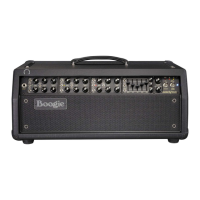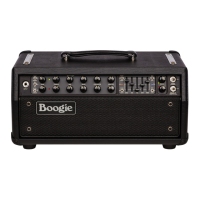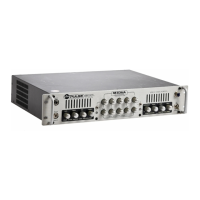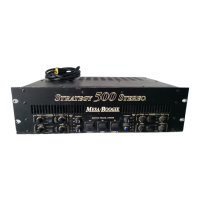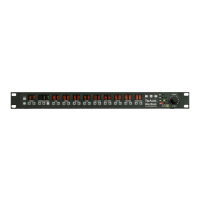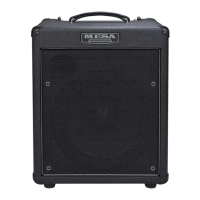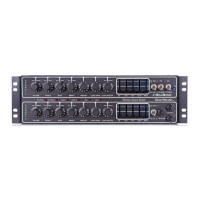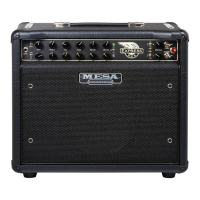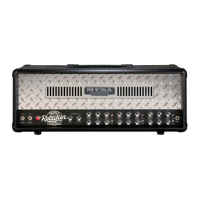PAGE 32
4 Ohm SPEAKER Output. The impedance will be a more correct match due to the fact you are using a dierent tap on the
transformer and two fewer power tubes. This is not essential but rather oers a dierent color and response.
When using two MESA 8 OHM cabinets - such as two 1 x 12 Extension cabinets or two (MESA) 4 x 12 cabinets,
the two 4 OHM SPEAKER Outputs should be used, one cabinet to each SPEAKER Output jack. Though each
cabinet will present a mismatch, together “wired in series” (internally), the total impedance load will be 8 Ohms.
This also will be a proper impedance match and allow the maximum power and headroom.
One 4 OHM cabinet (such as a 2 x 12 using 8 Ohm speakers wired in parallel) should be connected to one of
the two 4 OHM SPEAKER Outputs.
A 2 x 12 with 8 OHM speakers wired in series - presenting a 16 Ohm Load - should be connected to the 8 Ohm
SPEAKER Output. The maximum power will not be possible in this scenario, but it will be a mismatch in the
safe direction.
We use predominantly 16 Ohm speakers wired in series for our 2 x 12 Cabinets so that players can combine two
8 Ohm 2 x 12 cabinets - one in each of the 4 Ohm SPEAKER Outputs - as a way of getting 4 x 12 performance
and coverage in an easier-to-carry weight range and still get the same full rated power from the amplifier.
Some prefer the sound and feel of the 8 Ohm speakers themselves, citing more bold punch in the midrange
and top end that remains more attached and cohesive. In a 2 x 12 scenario (2 x 8 Ohm Speakers wired in paral-
lel at 4 Ohms total Load), and with a single such cabinet, use the 4 Ohm SPEAKER Output even though the full
rated power will not be available. Most players find it is more than enough headroom and power and accept the
trade-o in power for the dierence in voicing compared with its 16 Ohm-loaded 8 Ohm 2 x 12 counterpart. They
are both great-sounding cabinets, it’s just what you need and want in regard to overall voicing and power. The
standard 16 Ohm-loaded/8 Ohm version will be more scooped in the midrange and harmonic-laden, excelling
at rock and metal sounds, while the Custom Order 4 Ohm version will be more filled-in regarding midrange,
sound rich and balanced, and excel in most other musical genres with a bit more punch and cohesive, attached
top end.
NOTE: If you decide to order a 2 x 12 with 8 Ohm Speakers/4 Ohm total impedance, remember that you will not be able
to combine that with another cabinet as the amplifier is not designed to accommodate impedance loads below 4 Ohms.
MESA 4 x 12 cabinets can be treated just like the 1 x 12 Extension Cabinets, as they also present a total impedance Load
of 8 Ohms (each pair wired in series, then the pairs combined in parallel to achieve 8 Ohms total). Remember, it is not the
number of speakers but rather the total impedance that is important for your amplifier’s output transformer.
For more information and a recap of speaker impedance, wiring styles, and total Loads, see the Speaker Wiring section in
the rear of this manual.
EFFECTS LOOP
These two 1⁄4” jacks provide the interfacing patch points for your “rear-end” processing needs. The Eects
Loop is basically a circuit bridge from the end of the preamp to just before the Driver stage, with the SEND
interrupting the signal at the preamp’s end and the RETURN feeding the signal back into the power section
just before the EQ and the Driver tube.
Using this patch point usually ensures the best sonic performance as well as signal-to-noise ratio with your
outboard processors. That said, it is important to point out that this is a critical junction in the MARK VII’s circuit
path, and whatever is inserted here can have an eect on the overall performance of the amplifier.
The Eects Loop is a Series Loop, meaning that the entire signal goes through it, unlike a Parallel Loop, where a
percentage of the unaected pure signal is taken around the Loop and mixed back into the signal path alongside
that which has been redirected for processing. Therefore, the quality of the devices used in the Loop and their
performance is critical to achieving the best sound and performance from your amplifier. We recommend audi-
tioning any processor with your amplifier BEFORE buying it to ensure it delivers a good match in performance.
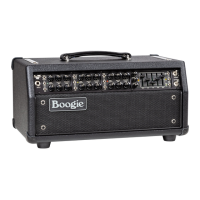
